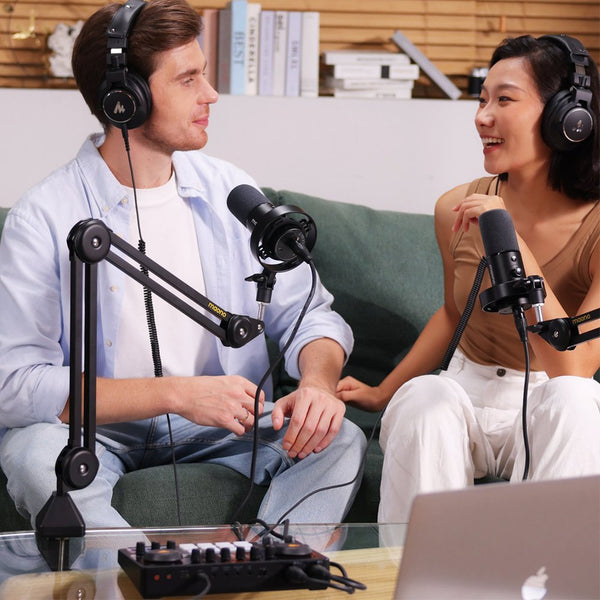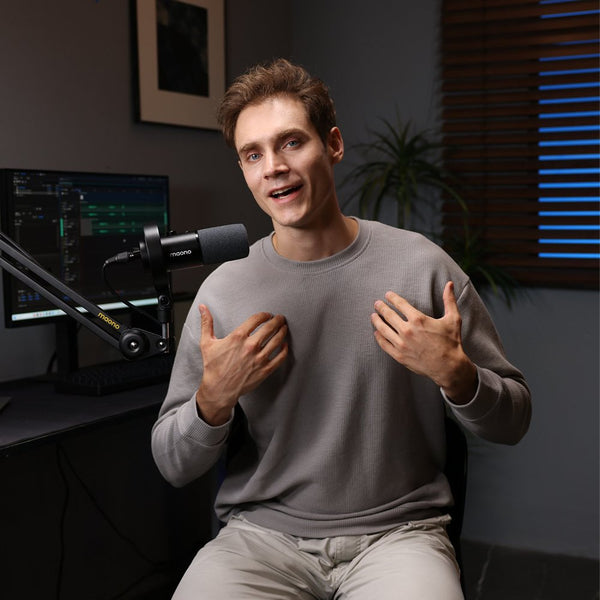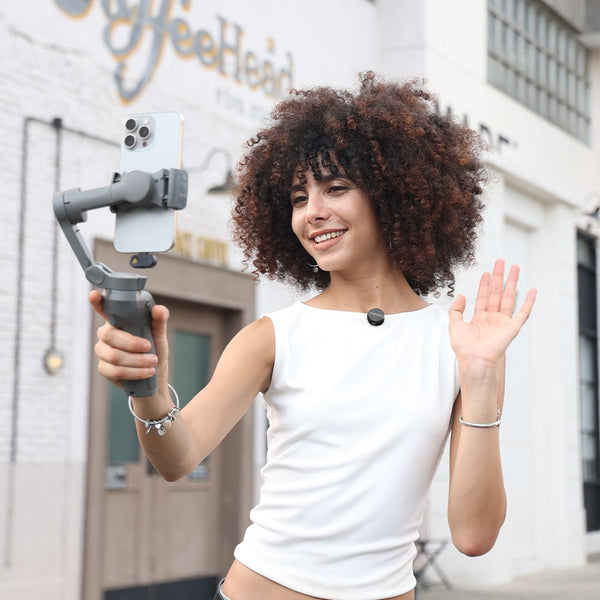Content, consisting of video and audio, should be taken seriously—especially if you're an expert in your field who wants to share advice and tips with your audience. To build trust, trainers and nutritionists are expected to deliver their message clearly using a reliable wireless microphone.
Now, in the age of digital wellness, fitness professionals and nutritionists are increasingly turning to vlogging to share valuable weight loss tips, healthy meal ideas, and training routines. With video content dominating platforms like YouTube, Instagram, and TikTok, delivering clear and engaging audio is no longer optional—it’s essential. Whether you're sharing a HIIT routine or a low-calorie meal prep guide, the quality of your sound can either elevate or undermine your credibility.
This article explores how trainers and nutritionists can use vlogs to effectively share their expertise, with a special focus on professional audio practices that help content stand out.
Creating Professional Fitness Vlogs: Audio Tips for Trainers
One of the most common mistakes new vloggers make is neglecting sound quality. Fitness environments, whether outdoor or indoor, often include background noise—music, people talking, equipment clattering. To ensure your voice remains the focus:
-
Use a wireless lapel microphone to maintain vocal clarity while moving freely.
-
Record in quieter time slots at your gym or park.
-
Test your audio setup before every shoot to avoid post-production surprises.
Wireless microphone lapel systems eliminate the need for handheld devices, allowing you to demonstrate workouts with hands-free audio while your voice stays consistently clear.
Filming Meal Preps and Workout Routines Using Wireless Lavalier Mics
Meal prep videos often involve chopping, sizzling, blending—sounds that can easily overpower your voice. Similarly, demonstrating squats or burpees requires distance from the camera. Here’s how wireless lapel mics help:
-
Clip the lapel mic near your collar to capture clear voiceover during cooking demos.
-
Choose a mic with noise-canceling features to minimize background interference.
-
For active sessions, make sure the mic clip is secure to prevent movement noise.
With a wireless mic, you can talk your audience through the benefits of high-protein meals or demonstrate form corrections in real-time—both crucial for building authority.
Personal Trainer Vlogging Essentials: Fitness Audio That Inspires
If your goal is to motivate your viewers, your voice must sound confident, enthusiastic, and natural. A few essentials include:
-
Use a foam windscreen or windproof to reduce plosives and breath sounds.
-
Opt for a mic with a wide frequency range to capture full vocal tones.
-
Practice pacing and modulation—monotone delivery disengages viewers quickly.
Remember, audio is emotional. A well-delivered message can energize your audience and make your vlog content truly inspiring. Good lapel mics enhance this experience, making your content feel more professional and personal.
Behind the Scenes: How Experts Record Diet Advice Without Distractions
Quiet, distraction-free audio is especially important when discussing detailed nutrition advice. Audiences must be able to hear every calorie count or portion tip clearly.
-
Record indoors with soft furnishings or acoustic treatment to avoid echo.
-
Turn off background appliances and silence notifications.
-
If you're recording voice overs, use script prompts to stay organized without sounding robotic.
When viewers don’t need to strain to understand you, your expertise shines through.
FAQ Section for Trainers/Nutritionists:
1. How can I record clean audio outdoors while sharing diet or workout tips?
Use a wireless lavalier mic with windscreen and noise reduction. Record during low-traffic hours and position the mic close to your mouth.
2. How can nutritionists make their vlog content more engaging?
Share relatable stories, include visual aids, and use dynamic audio to maintain interest.
3. What kind of weight loss tips are most popular in vlogs?
Quick meal preps, fat-burning workouts, calorie breakdowns, and progress tracking.
4. Can I share calorie breakdowns and still keep viewers interested?
Yes, by making it visual and explaining how it impacts daily goals or results.
5. How often should I post vlogs to stay visible as a personal trainer?
Ideally, 1–2 times per week to maintain consistency and build audience trust.
6. What affordable vlogging setup works for both fitness and food content?
A smartphone with a tripod, ring light, and wireless lapel mic is an excellent start.
7. Can I connect a wireless mic directly to my smartphone or action cam?
Yes. Many models like the Maono Wave T5 and T1 Mini offer plug-and-play mobile compatibility.
8. How do I sync wireless mic audio with workout video clips?
Use mobile apps like Kinemaster or CapCut, or desktop software like Adobe Premiere Pro.
9. What’s the best way to film a home workout tutorial with wireless audio?
Choose a quiet room, mount your camera or phone securely, use wireless audio, and check levels.
10. How do I give live voice-over during a training session?
Use a real-time monitoring wireless mic, and consider pairing it with a Bluetooth headset for control.
11. Should I script my nutrition advice or speak freely in my vlog?
Use bullet points to stay on track while sounding natural. Over-scripting may reduce authenticity.
12. How do I come across as credible and friendly in my vlogs?
Speak clearly, smile often, maintain eye contact with the camera, and share your personal experiences.
13. What types of vlogs help clients feel motivated to lose weight?
Before-and-after stories, workout challenges, and easy-to-follow healthy eating habits.
14. Which social media platforms are best for nutrition & fitness vlogs?
YouTube for long-form content; Instagram Reels, TikTok, and Facebook for short, engaging clips.
15. How do I engage my audience in comments after a fitness video?
Ask open-ended questions, respond quickly, and invite feedback on future content.
16. What keywords or topics should I focus on for weight loss vlogs?
"Easy fat-loss meals," "15-minute home workouts," "how to lose belly fat," "nutrition tips for beginners."
17. What’s the best wireless microphone for fitness vlogging?
Maono Wave T5 Wireless Lavalier Microphone

-
Dual-transmitter system ideal for trainer-collab videos or interviews.
-
Compatible with smartphones, cameras, and PCs.
-
Long battery life and real-time monitoring.
-
Noise cancellation ensures clean sound in gyms or outdoors.

-
Compact, ultra-portable design for on-the-go trainers.
-
Plug-and-play functionality for mobile vlogging.
-
Crisp audio capture with 4-level noise cancellation.
-
Great for quick tips, voiceovers, or short-form content.
Both wireless lapel microphone options offer excellent audio performance and are designed with content creators in mind.
Conclusion
Vlogging has become a powerful way for nutritionists and fitness trainers to educate, inspire, and connect with a wider audience. But no matter how compelling your workout or dietary tip is, poor audio can make viewers click away.
Investing in quality wireless lapel mics like the Maono Wave T5 or T1 Mini and applying smart recording strategies, can help you create engaging, professional-sounding videos that reflect your expertise. Whether you’re breaking down meal macros or leading a cardio blast, your audience will stay tuned in—and more likely to come back for more.
In the world of fitness and nutrition, your voice matters. Make sure it's heard clearly and confidently with the right vlogging audio setup.



